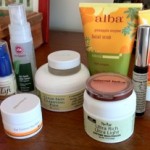By Sarah Finnie Robinson, Director of Social Programming at Practically Green
I am not one who can dash through the gleaming ground-floor cosmetics bazaar at Saks. No: I am the one you always see perched on a velvet highchair as a fleet of beauticians tsk-tsk over my gaping pores and fine lines and sell me tiny vials of exorbitant serums to solve my every tissue issue.
Well, that was then and this is now.
The bad news on conventional creams and gels has finally hit home. I’m a label reader now, and when I see words like Cocamidopropyl, Phenoxyethanol, Ethylparaben, and CI 17200 on a bottle, no matter how pretty that bottle is or how easy it is to fondle; and when I see warnings such as “Avoid contact with eyes” “Keep out of the reach of children,” and “For external use only,” I go all darkly suspicious.
I visited Practically Green to find out more. At switch to all-natural foundation, I read a concise explanation of the ingredients in conventional formulations, which can contain carcinogens, neurotoxins, irritants, and on and on.
It didn’t take much of this info to convince me. After all, what could it cost to replace my larder of chemical-laden demons with healthy alternatives? How can I afford not to stop using potentially dangerous ingredients on myself? Maybe I can’t stop Co2 from spewing into the air world-wide, but at least I can control what I put on my own little self.
Where to begin?
I’m fortunate to know Stacy Malkan of the Campaign for Safe Cosmetics and the author of Not Just a Pretty Face: The Ugly Side of the Beauty Industry. I interviewed Stacy a while ago to discuss Annie Leonard’s new movie The Story of Cosmetics, on which she collaborated. I explained my situation and asked her to please give her top advice, which I’d like to share here:
5 Tips for Finding Safer Products
- Simplify: Choose products with fewer chemicals, shorter ingredient lists and use fewer products overall.
- Avoid fragrance: This undisclosed mix of chemicals is likely to contain phthalates and other toxins. Choose products with no added fragrance and be sure to look for the word “fragrance” or “parfum” on labels — even fragrance-free products often contain a masking fragrance.
- Look up your favorite products in the Skin Deep database at www.cosmeticdatabase.org. Choose products with a score of 0-2.
- Avoid the Dirty Dozen: Here’s a short list of cosmetic chemicals to avoid. These aren’t the only problematic chemicals in cosmetics, but if a product contains one or more of these ingredients, it’s a sure sign that the company isn’t making the safest products.
- Support the Safe Cosmetics Act: We can’t just shop our way out of this problem, it’s also necessary to change the law to require companies to phase out carcinogens and to be transparent about what’s in their products. Take action to support the Safe Cosmetics Act.
Armed with all this advice, I set out for my closest Whole Foods “Whole Body” department. I was determined to stick with a $200 budget. [Gulp, I know: not cheap but a) it’s your face and b) it’s your life and c) what would I usually spend on this glop? Those salesladies at Saks are inveterate snake charmers.] I came home with my Baggu bulging full of intriguing new items. They’re pictured here along with two online purchases: a tiny tub of RMS “living luminizer” and a “Whispering Seas” mascara from Coastal Classic Creations. A friend named Rose urged me to try Zuii foundation, and I am loving that, too.
So far so good: After using the Weleda Iris Night Cream and the Avalon Organics “essential lift” cream for a couple of weeks, I could swear I’ve seen my worry lines vanish! Or maybe it’s simply that I’m just a lot less stressed now, having made such a healthy decision.
Thank you Stacy, Annie, and all the other smart, beautiful women out there teaching the rest of us to take better care of ourselves!
It feels great to tick off a whole bunch of the personal-care recommended actions at Practically Green, and I’m in the process now of submitting all my yummy new product recommendations on the site. I encourage you to do the same!
Author note:
 Sarah Finnie Robinson is the Director of Social Programming at Practically Green, a new website that coaches people on making eco-friendly and healthy everyday decisions. Follow Practically Green on Facebook and Twitter for more on living a green life!
Sarah Finnie Robinson is the Director of Social Programming at Practically Green, a new website that coaches people on making eco-friendly and healthy everyday decisions. Follow Practically Green on Facebook and Twitter for more on living a green life!
Other articles by Sarah on babybites’ blog:








Comments are closed.